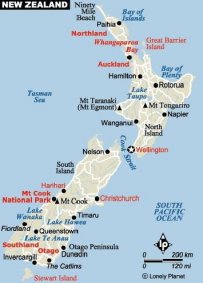| » | Guatemala |
| » | Honduras |
| » | Nicaragua |
| » | Costa Rica |
| » | Panama |
| » | Ecuador |
| » | Peru |
| » | Bolivia |
| » | Argentinië |
| » | Nieuw-Zeeland |
| » | Australië |
| » | Singapore |
| » | Maleisië |
| » | Thailand |
| » | Myanmar |
| » | Laos |
| » | Vietnam |
| » | Nederland |

|
|
     
Nieuw-Zeeland
Any number of vigorous outdoor activities - tramping (hiking), skiing, rafting and, of course, that perennial favourite, bungy jumping - await the adventurous. You can swim with dolphins, gambol with newborn lambs, whale-watch or fish for fattened trout in the many streams. The people, bound in a culture that melds European with Maori ancestry, are resourceful, helpful and overwhelmingly friendly. The extraordinary place names - try Te Awamutu, Whangamomona or Paekakariki for tongue-trippers - are resonant and, with a modicum of practice, easy to pronounce. Because it's such a compact place, travel within New Zealand - whether by plane, bus, rail, car or bicycle - is affordable and efficient. Accommodation too is cheap and varied. And the culinary promise of venison, fresh seafood, sublime ice cream and award-winning wines should more than whet the appetite. Facts Full country name: New Zealand Area: 268,680 sq km Population: 4 million People: 75% New Zealand European (Pakeha), 10% Maori, 5% other European, 4.5% Polynesian, 5% Asian, 0.5% other Language: Maori, English Religion: Predominantly Christian (75%) Government: Independent member of the Commonwealth of Nations Head of State: Queen Elizabeth II Head of Government: Prime Minister Helen Clark GDP: US$85 billion GDP per capita: US$22,360 Annual Growth: 2% Inflation: 2.7% Major Industries: Food processing, wood and paper products, wool, textiles, dairy products, iron and steel, machinery, tourism Major Trading Partners: Australia, Japan, UK, China and the USA Bron: www.lonelyplanet.com |
